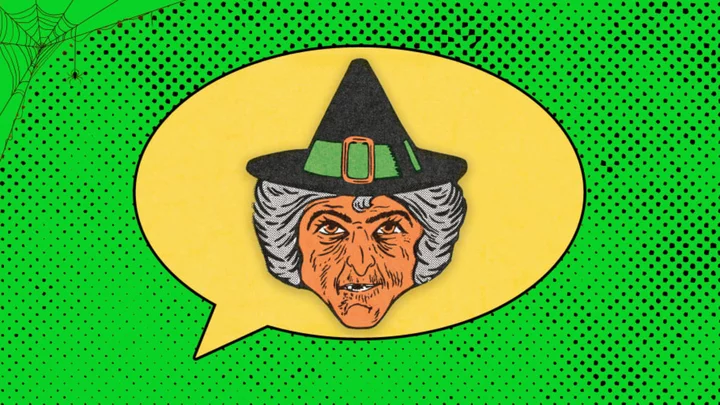Witches are as much a staple of Halloween as candy apples and trick or treating, and witch hunts have become a perennial part of political discourse—so it’s easy to feel the word witch is a little overused. Fortunately, there are plenty of lesser-known words for witches from the past and around the world. Stick these terms in your cauldron and pass them around your coven.
1. Sorceress
What makes a witch a witch? One element is magic, or sorcery, and not the rabbit-out-of-a-hat, Job-Bluth type—but evil, sinister black magic. No wonder sorceress has been a word for witches since the 1300s. An 1885 example from William Pater’s novel Marius the Epicurean uses the term in the witchy sense: “In one very remote village lives the sorceress Pamphile.” Sorceress is one of many variations of sorcery recorded by the Oxford English Dictionary (OED), including sorcering, sorcerous, sorcerously, sorcerist, and sorcerize.
2. Enchantress
Similarly, this term has also been around since the 1300s and is first recorded in use by poet Geoffrey Chaucer. Enchantress first applied to witches but over time spread to women who are simply enchanting or enthralling in the non-sorcerous sense.
3. Hellcat
The OED defines this term, which originated in the early 17th century, as “An evil person, suggestive of a creature from hell; a monster.” Less than a decade after it first popped up, hellcat was being used to refer to witches (which makes sense, since cats and witches have long been associated). A hellcat can also be any evil or wild woman or girl, even those lacking a cauldron.
4. Wise Woman
Wise woman, which first popped up in the late 1300s, is one of the more complementary words for witches or women magicians, and according to the OED, it referred to “harmless or beneficent” ones who worked against dark forces like disease and “malignant witchcraft.” By the 19th century, the term was also used to refer to a job that’s considerably less spooky: a midwife. A similar term for a midwife is sage woman.
5. Lamia
Do you like fabulous monsters? Then you’ll appreciate the OED’s definition of lamia’s main sense as “A fabulous monster supposed to have the body of a woman, and to prey upon human beings and suck the blood of children.” (Of course, that’s fabulous in the fabled sense.) The term also applies to witches and “she-demons.” Lamia is a borrowing from Latin that appears in some of the first English translations of the bible. You might also recognize the monster from Sam Raimi’s 2009 film Drag Me to Hell.
6. Bewitcher
Since the 1500s, this term has applied to witches and other sorcery-slingers. It recalls the title of Bewitched, and variations of the term are often used in a softer sense (and without the involvement of an eye of newt), like bewitching, meaning “alluring or entrancing.”
7. Pythoness
Here’s another -ess word, part of a trend completely out of fashion today. The OED defines pythoness, which dates to the late 1300s, as “A woman believed to be possessed by a spirit and to be able to forsee the future; a female soothsayer; a witch.” We can thank both French and Latin, and the association of snakes with sorcery, for this borrowed term.
8. Weird
This sense of weird is a noun—as in, “Weirds like to transform dudes into frogs”—unlike the popular adjective that can apply to almost anything these days. The OED defines this sense of weird, recorded since the 1600s, as “One pretending or supposed to have the power to foresee and to control future events; a witch or wizard, a soothsayer.” So a bunch of sorcerers and sorceresses could be called “a group of weirds.” This use fits like a sibling with the weird sisters from Macbeth.
9. Baba Yaga
The OED defines the Baba Yaga as “(the name of) a witch or female demon” who appears in Russian and Slavik folklore. The Baba Yaga also figures prominently in the Hellboy comic book and other tales, and in most iterations she is a voracious eater of children. (Some other terms for female demons, in the event you need them, are she-demon, demoness, she-devil, or deviless.)
10. Hag
Though this term evolved to describe—in a sexist and ageist manner—women who are old and unattractive, its original 13th-century meaning was quite sinister: At that time, hag referred to a woman who cavorted or at least conversed with the devil. Crone, which popped up slightly later, has also been used in a similar way.
11. Witch-man
We can’t leave men off the hook when it comes to witchery. Warlock—which had a number of meanings in Old English, including “traitor,” “scoundrel,” and “Satan”—has been a term for a male witch since around the 1400s, and witch-man has also been used since the 1500s. The latter term still turns up from time to time, appearing in Nigel Pennick’s 2011 book In Field and Fen: “The Witch-men described by Sternberg, stuffed straw into their smocks to give the illusion of humped backs.”
12. and 13. Cunning Woman and Cunning Man
To be cunning is to be clever and knowledgeable, but another sense of the word dating to the late 1500s denotes knowledge in magic or witchcraft. A cunning man is a wizard, and a cunning woman is a witch. An 1807 use from a letter of Robert Southey mentions both: “A Cunning-Man, or a Cunning-Woman, as they are termed, is to be found near every town.” Well, that’s convenient.
This article was originally published on www.mentalfloss.com as 13 Weird Old Words for Witches and Warlocks.

